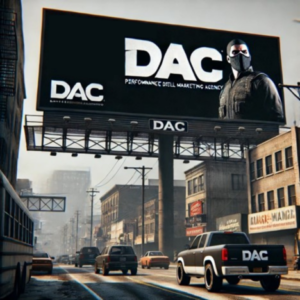
Amplify your reach and drive results with our tailored paid media strategies.

Video gaming is the fastest-growing form of entertainment over the last 10 years and is projected to more than double by 2032 (reaching over $1 trillion USD). That makes advertising within video games a strategic opportunity that’s not only about reaching loyal audiences but scaling your marketing efforts in a dynamic and engaging environment.

Forward-thinking brands are increasingly recognizing the untapped potential of video game advertising. Little Caesars, for instance, teamed up with Activision for a co-branded campaign tied to the release of Call of Duty: Modern Warfare III, incentivizing users to purchase pizza in exchange for in-game rewards. Similarly, Nike partnered with Fortnite to promote its new Air Jordan 1, offering users the chance to buy a virtual version, which in turn fueled interest in the real-world sneaker. And one of our DAC’s own clients, Bridgestone Tires, collaborated with motorcycle-related mobile games to engage enthusiasts through highly interactive platforms, aligning their product messaging seamlessly with relevant gameplay.

Gamers aren’t just passively playing—they’re immersed in the experience. Many even recognize and engage with brands because they encounter them in gameplay. For instance, Roblox players explore virtual Gucci stores, building a deeper connection with the brand. And today’s gamer demographic isn’t confined to teenagers; according to Statista, gamers aged 35-54 make up nearly the same proportion as those aged 16-24.

In-game ad formats offer endless possibilities, from traditional banners to custom-designed character skins. Here are some key examples:
Subscribe to our monthly newsletter.
Gamers don’t just passively consume—they actively engage. If your ad feels like a cool addition to the game instead of an interruption, you can build serious brand loyalty. Think of The Sims, in which players can design their virtual homes using IKEA furniture. This clever integration turns brand engagement into part of the fun, subtly reinforcing brand recognition as players enjoy creating their stylish spaces.

Similarly, imagine DAC’s logo seamlessly integrated into a GTA environment, as shown in the AI-generated image below. By embedding brand visuals into gameplay, advertisers create memorable experiences that blend with players’ surroundings, enhancing brand recognition without breaking immersion. This type of in-game branding fosters organic engagement, leaving a lasting impression as players interact with familiar visuals throughout their gaming experience

(AI-generated image)
Gaming has become highly social, opening the door for cross-promotion with industries like movies and music. Brands that align with pop culture trends or blockbuster games can achieve major exposure. Take the recent Barbie movie phenomenon—brands everywhere jumped on that bandwagon, from fashion to fast food. A similar opportunity looms with the highly anticipated Grand Theft Auto 6, expected to be one of the most popular games of the century. With Grand Theft Auto 5 already generating over 168 million hours of live streaming in 2024, the hype is real, and brands can expect big cross-promotion opportunities as GTA 6 rolls out.

Interrupting an engaged gamer’s flow can backfire. Ads must fit naturally into the gaming environment, enhancing rather than disrupting the experience. Relevancy is key to ensuring your ads don’t break the immersion.

Tracking the impact of in-game ads can be tricky, as it’s not always easy to directly correlate in-game engagement with real-world revenue. A comprehensive analysis across marketing channels is crucial. . However, it’s important to remember that immediate action might not follow; in-game ad impact often takes time to manifest.
While gamers love their games, too many ads can lead to burnout. Striking a balance between exposure and ad fatigue is essential—monitoring ad frequency ensures your message is seen but not oversaturated.
The gaming world can sometimes be controversial, with some games featuring violent or sensitive content. It’s vital to carefully vet the games in which your ads appear, ensuring alignment with your brand’s image and values.
Advertising in video games is like stepping into a whole new world—literally. There are endless possibilities for reaching audiences in unique and creative ways. But, like any game, there are challenges that require smart strategy and quick thinking. Whether you’re a small brand testing the waters or a big brand looking to level up, in-game ads can be a game changer. Just remember to play it cool, be authentic, and keep your eye on the prize.
At DAC, we understand the power of immersive experiences like video game advertising and how they can fit seamlessly into a broader, full-funnel campaign. Whether you’re looking to reach highly engaged gamers or align your brand with the latest in interactive entertainment, our team has the expertise to craft strategies that resonate. Ready to take your brand to the next level with video game advertising? Let us help you build a winning campaign that drives results from awareness to conversion.
Amplify your reach and drive results with our tailored paid media strategies.
Amplify your reach and drive results with our tailored paid media strategies.
Subscribe to our monthly newsletter.